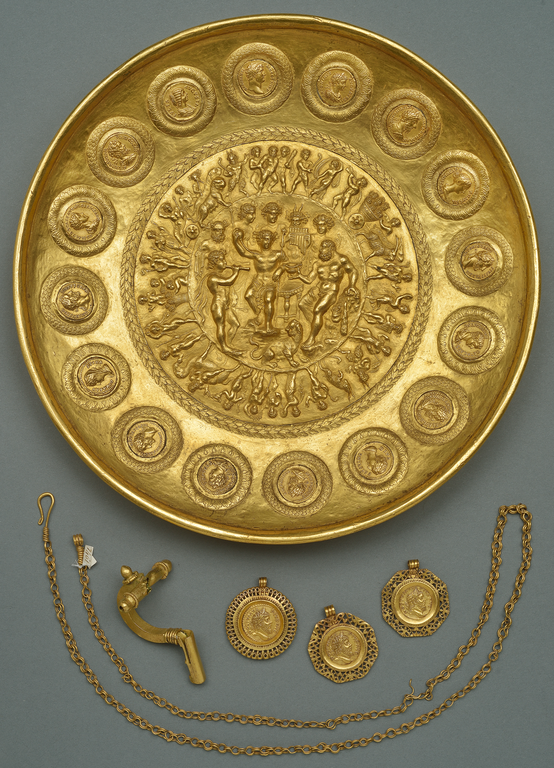The Rennes Treasure

The Rennes Treasure
- Medium:
- Gold
- Dimensions:
- Bowl: H. 4 cm; Diam. 25 cm;; L. 76 cm; Diam. 3.5 cm; H. 3.7 cm; L. 3.2 cm; H. 7 cm
- Context:
- Rennes-le-Château, France
- Date:
- Roman, ca. 210 CE; Roman, ca. 263 CE; Roman, ca. 275 CE
- Inventory Number:
- inv. 56.94; inv. 56.131; inv. 56.147 (Chab.2561); inv. 56.148 (Chab.2562); inv. 56.149 (Chab.2563); inv. 56.272 (Chab.2687)
- Lender:
- Bibliothèque nationale de France, Paris
Discovered in 1774, this gold treasure was unearthed during the demolition of a house in Rennes, Brittany (northwestern France). The cache consisted of ninety-four aurei (imperial coins); a figured bowl with sixteen inset aurei; four fragments of a chain; a fibula (brooch); and four aurei set in openwork mounts to serve as pendants. The loose coins (not on view) date the treasure’s burial to about 275 CE. One pendant and a portion of the chain have been lost.
Made of 23-karat gold, this bowl is the most ornate of the few Roman gold vessels that survive. The central medallion depicts the drinking contest between Bacchus and Hercules—an allegory of the victory of wine over physical strength. Crowned with ivy, the wine god sits on a stool and carries a drinking horn and thyrsus (ritual staff). He is surrounded by followers, including a satyr playing the double pipes and the horned Pan with a panpipe. Hercules, at right with his lion skin and club, holds a cup. Encircling the scene is a frieze with the triumphal procession of Bacchus, in a panther-drawn chariot behind Hercules, who is drunk and supported by two figures. The bowl is further adorned with coins of emperors and empresses from Hadrian to Geta, set within alternating acanthus and laurel wreaths.